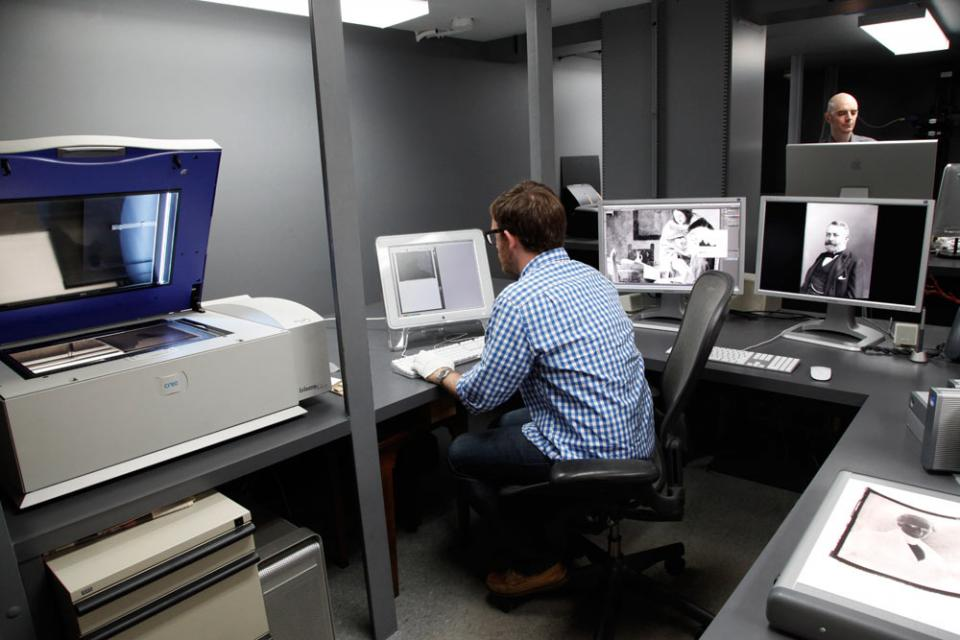Digital Evolution at the Frick Art Reference Library
July 20, 2018 - All
For this interview I spoke with Luciano Johnson, who works within the Digital Lab at the Frick Art Reference Library. The institution boasts a comprehensive in-house digitization program which has continued to grow and adapt to new technology.

Q. What is your official job title?
I am a Digital Preservation Librarian.
Q. How many years have you had this position?
That’s a very good question, I started in this department as a digital technician. I think I have had this title for about four years since I switched from that position.
Q. What is your education background?
I have a MSLIS from Pratt. Prior to that, I received a BA in English from Marymount Manhattan.
Q. What are your typical duties or activities in a day?
Well…managing the lab, managing the servers, managing any of our digital projects and grants. Then any day to day digital preservation activity which includes metadata transformation, file transferring, and managing staff. I also work on the public interface, the access portal for users.
Q. What are some of the most satisfying elements in your work?
When we successfully complete projects, having a good team is very satisfying, a dependable team, and working on the access portal. Generally, just making things work and solving problems is very satisfying.
Q. What is the overall goal of the department?
The overall goal of the department has two parts: to create quality digital objects and ensure the long-term access and use of those objects.
Q. What are some of the challenges that your department or institution faces?
I think the typical ones, such as financial or budget limits. Making decisions of what we keep and don’t keep and in that sense what gets digitized and what doesn’t. And as usual, trying to satisfy the different requirements of other departments.
Q. How has the department grown over the years?
Well I want to say in 2001 there was one person working as a digital lab person and it was mostly just sending stuff out and getting his sea legs. So we went from no onsite digitization and one technician to now six and a half full time employees. That includes my position, a photographer, two full time digital technicians, three part time digital technicians, and one full time digital projects coordinator. That’s just within our specific department, there are other departments that are also spending quite a lot of time with these digital objects.
Q. How does your department prioritize tasks? What is most important?
For us at this point, grant funded projects always get the highest priority. From that we go into anything that comes in that’s new or rare or fragile material we would digitize. Also projects that are part of the institution’s larger goals of creating more space, in other words driven by the Frick Collection’s long-term plans and projects.
Q. How could the institution improve on its digital strategies in the future?
Well I think what we are looking at is finding a digital preservation system solution that is sustainable long term under whatever budget restrictions we are given. Once we have a more fitting idea of how that might work I think we will have a better idea of how we can stabilize everything. One of the biggest things is also cohesion so making sure once we have that set up we have to ensure that we are finding and gathering everything because I think one of the issues or challenges is we haven’t necessarily gone out and found all of the born digital items that are out there for the museum as a whole and to make sure that we have grabbed them and made a copy. Once we have a more streamlined system that is how we will be able to improve and carry out those goals.
Q. Do you have any advice for students wanting to pursue a career in the profession?
One of the things I have noticed from talking to people is that something increasingly important is one’s ability to work across departmentally or work with a lot of different people and try to bring their goals together and unify those goals. I think in a lot of places you get bogged down by everyone trying to remain separate and one of the positions that I think, especially in large institutions, is having people tie those departments and those projects together. It’s something that is missing in a lot of departments because some people get into this field because they don’t want to work with other people, and I think that’s fairly problematic. I think having a very strong technical background would be really helpful. It is also definitely helpful to keep up and try to go to some of those conferences and keep up with what’s going on because there is a lot to gain from knowing what other people are doing and knowing what can be done.
Digital Evolution at the Frick Art Reference Library was originally published in Museums and Digital Culture – Pratt Institute on Medium, where people are continuing the conversation by highlighting and responding to this story.